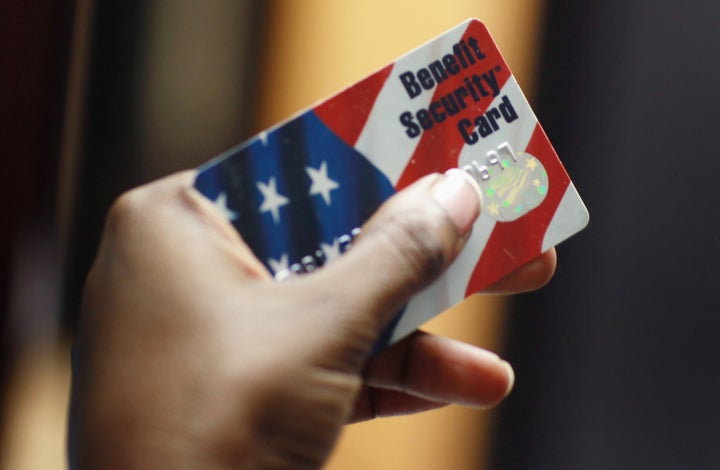
Comments in response to my most recent post -- and all of my posts, for that matter (and perhaps everyone else's) -- predictably cluster at the poles. The more conservative among us object from my right, the more liberal from my left. What tends to be overlooked in the process is not only the potential promise of a middle path but the slippery slope toward quagmire in either direction.
With that in mind, along with the adage "one man's meat is another man's poison," let's revisit the use of SNAP funds.
We could say: It's not their money, so of course food choices can/should be regulated. Leaving aside the contradiction in a government that is too big by offering food assistance in the first place, but too small by not regulating how it's used -- let's consider the implications. What is out of bounds?
Is a breakfast cereal with a first ingredient of sugar (candy by another name) but fortified with 11 essential vitamins and minerals and "part of a complete breakfast!" within bounds, or out of bounds? I personally consider such products the lousy part of a complete breakfast, and no one in my house eats them. If you want to pour milk over a multivitamin, you might as well leave out the jelly beans.
What about salad dressing or pasta sauce with more added sugar than ice cream topping? Oh yes, those products are out there -- on every supermarket shelf in the country. Are food stamps good for them, or not?
What about a bacon cheeseburger well-slathered with ketchup and served on a white bun? Talk about one man's meat! Most Americans would view this as the perfect meal, I suppose. But nutritionally, it is in fact a delivery vehicle for almost every excess that plagues the typical American diet: saturated fat, trans fat, starch, sodium, sugar and calories. Are food stamps good for that?
So the argument for regulation succumbs quickly to the devilry in the details. Can you just imagine the committees, hours and tax dollars required to address systematically where to draw all the lines that distinguish in bounds from out of bounds? We will probably need a whole new government agency.
But look in the other direction: no regulation at all. Then, money from the common pool specifically intended as a safeguard against true hunger could be used for candy and soda. Since poor dietary choices, adding up to poor diet, constitute one of the -- if not the -- single greatest sources of chronic disease and premature death, allowing food assistance to go in that direction clearly threatens to turn "live and let live" into "live and let die." We find ourselves very close to the no-strings-attached line, where public assistance is simply a blank check. It might as well be used for alcohol or tobacco.
As many noted in response to my prior blog, it's not "their" money -- it's "our" money. But that, too, is a slippery slope. Medicare is paid for with "our" money. If older people on Medicare didn't eat so badly, they would have less chronic disease -- and thus would burn through less of "our" money caring for pathology that need not have arisen. So should the food choices of everyone on Medicare be regulated, too? How about everyone on Social Security? Are those who contend we have too much government in play already by offering such assistance in the first place really suggesting we need a whole new government bureaucracy to regulate how it's spent?
The position I was advocating -- using an objective measure of nutritional quality to apply a system of financial incentives -- was not about ideology, despite all of the ideological opposition it engendered. It was about epidemiology. My view always is epidemiology over ideology. Let's do what actually works. If we don't know what works, let's test the things that might and find out.
Food assistance dollars are already regulated to some degree -- they cannot be used to purchase tobacco. So this is not "no strings attached" money. Once there are strings, we are invited to think collectively about how best to tie up loose ends.
Advocating for regulation is easy -- but for it to be done in a manner that is not haphazard and arbitrary, the nutritional quality of tens of thousands of foods has to be judged, reasonably and objectively. That's a lot of work. I know, because we've done it.
Much dialogue about public health policy and practice takes place at the poles. And there is peril for us all in that. Because at the poles we cannot hear one another. At the poles, we listen only to ourselves. At the poles, we are too far apart to ever get together. And so, in fact, there is no dialogue -- there is just competing monologue. And nothing gets done.
At times, our inalienable convictions will place us at a pole. So be it. But surely, this needn't happen all the time.
There is no real difference between a system of financial incentives and one of disincentives, except that one feels better than the other. Either way, you win doing one thing and lose doing another. A carrot withheld is a bit like a stick.
But they do feel different, and the incentive approach honors the autonomy of the individual, even while providing a nudge in the right direction.
Linking a system of financial incentives to a system of objective nutrition quality scores allows for the fact that one man's meat may be another man's poison, while addressing a status quo that is poisonous to all concerned.
-fin
Dr. David L. Katz; www.davidkatzmd.com
www.turnthetidefoundation.org